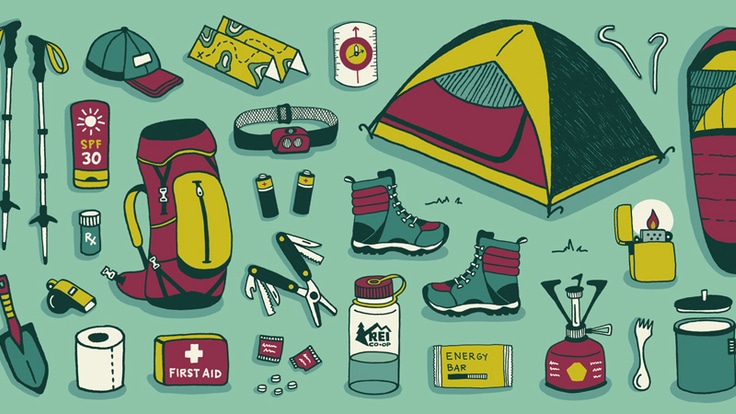Backpacking—hitting the trail with nothing more than life's necessities on your back—is the quintessential outdoor adventure.
To determine what you need to bring on a backpacking trip, think about how far you plan to hike, how remote the location is and what the weather forecast has in store. In general, the longer and/or more remote the hike is and the more inclement the weather, the more clothing, gear, food and water you're going to want. If you're just getting into backpacking, be sure to read Backpacking for Beginners before you head out.
What to Bring Backpacking
These items should be part of your backpacking checklist:
- Hiking boots or shoes
- Backpack
- Tent
- Sleeping bag and sleeping pad
- Stove and fuel
- Kitchen supplies
- Plenty of food
- Water bottles and water-treatment supplies
- Weather-appropriate clothing
- Emergency and hygiene supplies
- Small repair kit
- The Ten Essentials
How to Use This Backpacking Checklist
While you're packing, use this handy backpacking checklist to make sure you don't forget anything important. Here are some notes on how to best use this list:
- The Ten Essentials: Items that are part of the Ten Essentials are marked by an asterisk (*). The exact items you take can be tailored to your trip based on considerations such as weather, difficulty, duration and distance from help. To learn more, see our article on the Ten Essentials.
- This checklist is deliberately comprehensive and intended for trips in the backcountry where being self-sufficient is important to your well-being. Backpacking planning requires you to balance keeping pack weight low with ensuring you have the essentials you need for your particular trip.
- Printer-friendly PDF: Print out the PDF version for easy use at home.
Printer-Friendly Version (PDF)
Backpacking Gear
A backpacking pack that holds 30-50 liters is about right for overnight trips; go with packs in the upper end of that range if you'll be out for two or three nights. For more details, read How to Choose a Backpack.
- Backpack with raincover
- Backpacking tent (with stakes, guylines)
- Sleeping bag (with stuff sack)
- Sleeping pad
- Headlamp or flashlight *(with extra batteries)
Optional:
- Trekking poles
Packable lantern
- Tent footprint (for extra floor protection)
Backcountry Kitchen
Food & Water
For the trail, pack snacks like energy bars, jerky, hard cheeses and nuts that you can eat easily on the move. For lunch, plan on a more robust snack break. For other meal ideas, read Menu Planning for Backpackers.
Planning your water carrying needs requires you to look closely at available water sources where you're going. A general recommendation is to drink about a half liter of water per hour of moderate activity in moderate temperatures. Learn more about how much to drink.
- Energy food and drinks (bars, gels, chews, trail mix, drink mix)
Extra day's supply of food
Clothing & Footwear
Check the forecast and make sure to dress for the conditions. To be prepared for changing weather or an unplanned night out, pack extra clothes beyond those required for the trip. It's also important to consider how much protection your clothing provides against the sun's ultraviolet rays. For footwear, determine what to wear based on the terrain. On gentle hikes on smooth trails, hiking shoes or trail runners are sufficient. For treks on rocky, rugged trails, boots will provide more support. Learn more about choosing hiking clothing and footwear.
- Socks (synthetic or wool)
Extra clothes (beyond the minimum expectation)
Additional items for rainy and/or cold weather:
Optional:
Navigation
Navigation is one of the Ten Essentials systems. The type of trip you're taking and your personal preferences will determine exactly which items you'll bring. If you like to use a GPS, note that it's not a substitute for a map and compass.
Optional:
Emergency & First Aid
One of the Ten Essentials is an emergency shelter. Even if you're carrying a tent with you, you should also have an emergency shelter if you plan to take day hikes away from your base camp.
- Fire starter (for emergency survival fire)
- Emergency shelter
Two itineraries: 1 left with friend + 1 under car seat
Health & Hygiene
- Hand sanitizer
Toothbrush and toothpaste
- Sanitation trowel
Toilet paper/wipes and sealable bag (to pack it out)
- Menstrual products
Prescription medications
Prescription glasses
Sun protection:
Optional:
Tools & Repair Items
- Knife or Multi-tool
- Repair kit (include mattress/stove supplies)
- Duct tape strips
Backpacking Extras
All of the following items are optional, and you'll need to decide how much you're willing to carry if you decide to bring one or more of them along.
- Daypack (for day trips away from camp)
- Camera or action cam (with extra memory cards)
- Interpretive field guide(s)
Star chart/night-sky identifier
Personal Items
- Permits (if needed)
Credit card and/or cash
ID
- Car keys
Cellphone



